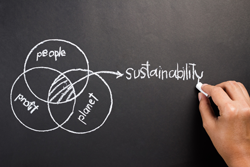 Sustainable procurement is the use of purchasing “to support wider social, economic and environmental objectives, in ways that offer real long-term benefits” – promises many possible benefits for both organisations and the communities in which they exist. These potential positives range from the reduction of an organisation’s carbon footprint to a significant list of long-term business benefits. But with sustainable procurement comes a number of other challenges that can threaten the viability and success of this approach to supply chain management.
Sustainable procurement is the use of purchasing “to support wider social, economic and environmental objectives, in ways that offer real long-term benefits” – promises many possible benefits for both organisations and the communities in which they exist. These potential positives range from the reduction of an organisation’s carbon footprint to a significant list of long-term business benefits. But with sustainable procurement comes a number of other challenges that can threaten the viability and success of this approach to supply chain management.
A boon to business
Over recent decades, businesses the world over have embraced the concept of sustainable procurement. From the likes of Nestlé, Danone and Unilever’s commitment to zero-deforestation, to the sustainable supply chain policies of global retailers like Tesco and M&S, companies understand that what’s good for the environment can also be good for business.
The business benefits of sustainable procurement come in various guises:
- Significant cost savings from focusing on a “whole life costing” methodology for purchasing, and placing increased emphasis on reducing, reusing and recycling, to cut waste and improve the efficiency of resources.
- Improved management information enabling tighter control of business risk and facilitating better supplier management.
- Enhancing an organisation’s public image by demonstrating a sustainable approach to business and championing related environmental and social benefits.
- Opening up fresh markets for new products and services through technology and innovation.
- Stealing a march on the competition through the early adoption of practices dictated by increasingly environmentally-focussed legislation.
Sustainable procurement can be a challenge
But despite these and other benefits, a sustainable procurement programme brings with it some significant challenges. Externally, an organisation’s normal and existing market may not be capable of supporting their sustainable and environmental ambitions, added to which it may be more difficult to identify suitable suppliers using traditional methods. Furthermore, the range of sustainably sourced or produced products and services will most likely be more limited, bringing the risk of higher purchasing prices.
Within the business, it may take longer to research, evaluate and engage sustainable suppliers than at present. Then there will be additional challenges associated with the implementation and enforcement of a sustainable procurement policy across buying teams and staff.
Meeting the challenges with eProcurement
eProcurement can help overcome these issues thanks to the way it streamlines processes, speeds up timeframes, reduces overheads and helps open up marketplaces. In essence, a next-generation eProcurement system will enable:
- Quicker, easier sourcing and engagement of new suppliers.
- Easier and more direct access to sustainable products and services, over a wider geographical area, via e-cataloguing.
- Automated management, better visibility and more centralised control of existing suppliers.
- Tighter ongoing management, reviewing, and credential-checking (of environmental policies, certification and disclosures) of suppliers.
- Automation of information and document exchange with suppliers.
- Internal enforcement of sustainable procurement policy using automated workflow and process management. Furthermore, the reduction of manual processes results in the use of fewer resources and lower energy consumption.
- Automation of finance, invoicing and credit control processes, again reducing manual input and paper flow.
- Tracking and analysing spend and savings more easily and accurately, enabling better price negotiation and management and helping to demonstrate the success and viability of sustainable procurement.
Balancing control, benefit and payback
To implement a successful sustainable procurement programme, organisations need to juggle a significant number of balls at once. They must be able to more closely monitor and control suppliers and employees, have tighter control of pricing, produce better management information and at the same time be able to clearly demonstrate the success of their programme to a variety of audiences.
Businesses also need to have the appropriate budgetary mechanisms in place to facilitate and promote sustainable procurement. Finally organisations looking to deliver sustainable procurement must ensure they employ appropriately skilled resources – and then support them with the necessary technical infrastructure and tools.
For more information on NexProcure, our next-generation eProcurement solution visit the products page or contact us.

